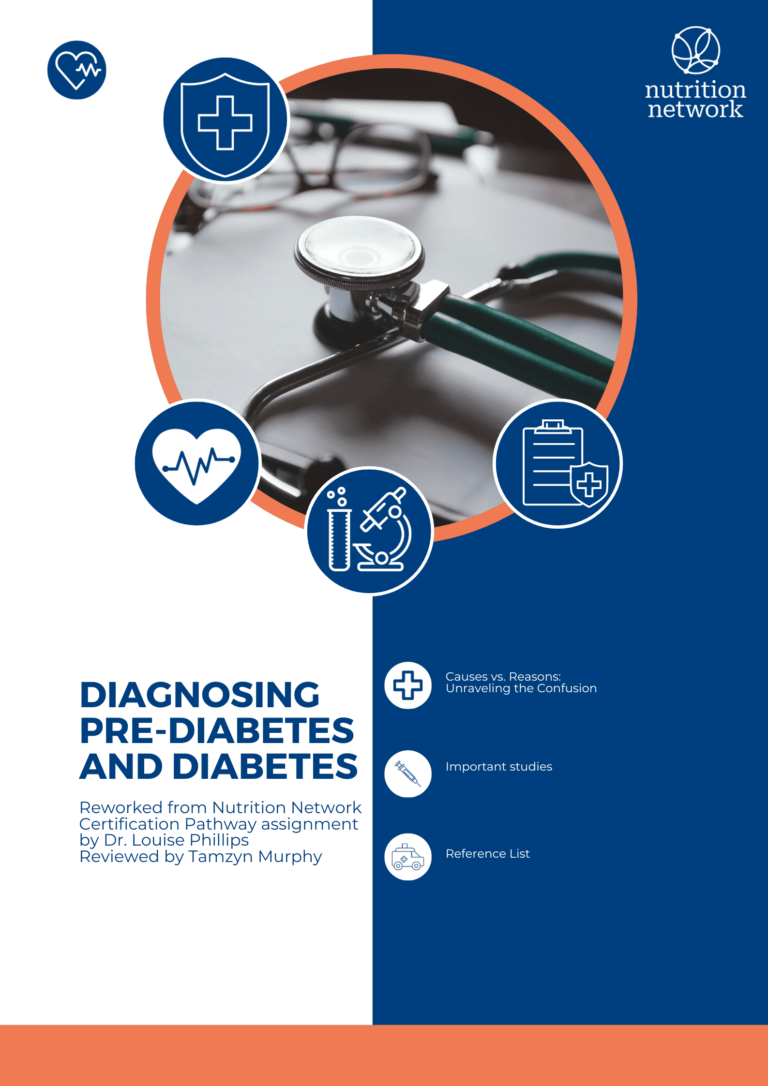Reconstructed from the Food Network Certification Pathway assignment by Dr. Louise Phillips, MD
Reviewed by Tamzyn Murphy
Diagnosing diabetes and pre-diabetes is based on meeting specified cut-offs of three tests, namely oral glucose tolerance test (OGTT), fasting blood glucose (FBG) and glycated hemoglobin (HbA1c). The criteria vary depending on the country or organization that sets the standard. While these reports are easy to find, there is controversy about the various cut-offs, their sensitivity and specificity, and the impact on patient care and outcomes.
In Australia, type 2 diabetes is diagnosed with either FBG (after 8 h fasting) ≥ 7 mmol/L, 2 h OGTT (with 75 g glucose load) ≥ 11.1 mmol/L or HbaA1c ≥ 48 mmol/mol. Asymptomatic patients require a second laboratory test as confirmation, whereas symptomatic patients do not (1). Symptoms include lethargy, polydipsia, polyuria, blurred vision, decreased sensation, frequent infections, and poor wound healing (1). The diagnosis of prediabetes is established by any HbA1c 42-46 Mmol/mol, impaired fasting glucose (IFG) (6.1-6.9 mmol/l) or impaired glucose tolerance (IGT) with 2-hour blood glucose 7.8-11 .1 mmol/L by OGTT (2).
Table 1 compares the definitions of prediabetes for the World Health Organization definition, with the American and Australian Diabetes Associations (3).
Table 1
Determining the optimal thresholds for the diagnosis of both diabetes and prediabetes is important because 30–40% of diabetics are undiagnosed and microvascular and macrovascular complications are present in 25% of prediabetic patients (4).
In Bulgaria, a cross-sectional survey was conducted in 2231 subjects (men and women who had at least one risk factor for diabetes) with a mean age of 50.3 years to evaluate HbA1c as a diagnostic tool for prediabetes, IFG, IGT and diabetes. They found that the optimal HbA1c cutoff for diagnosing diabetes was 6.1% (43 mmol/mol) with a sensitivity of 86% and a specificity of 92%. Meanwhile they recommended a cut-off point for prediabetes of 5.5% (37mmol/mol) with a sensitivity of 71% and a specificity of 64%. Comparative use of the ADA criteria for prediabetes of 5.7% (39 mmol/mol) showed a reduced sensitivity of 66% (with a specificity of 65%), while the ADA threshold for diabetes with HbA1c of 6.5% (48 mmol/mol) had lower sensitivity 76% (with higher specificity 94%) (4).
An important study is the ARIC (Atherosclerosis Risk in Communities study), which was a community-based prospective cohort study of 15792 middle-aged adults (USA) and is one of the largest community-based studies of HbA1c and its association with the development of diabetes and cardiovascular diseases. CHD risk was found to increase from HbA1c 5.5 (37 mmol/mol) with HR 1.36 (CI 1.22-1.56) and this risk increased progressively with increasing HbA1c levels (5).
A ‘regulate, rule out’ approach to HbA1c with ‘rule out’ HbA1c 5.5% and ‘regulate’ at Hba1c 7% has been suggested as the most appropriate (6).
Given the continuum of prediabetes and diabetes and the fact that hyperinsulinemia increases complications in the absence of hyperglycemia, I believe that lower thresholds for the diagnosis of prediabetes and diabetes are needed. Ideally, early diagnosis should be accompanied by nutritional intervention in the ear, which will ultimately reduce costs to the health care system. Therefore, I highlight an Hba1c of 5.5% and above with patients and recommend intervention thereafter.
Reference list
1. Royal Australian College of General Practitioners. Management of Type 2 Diabetes: A General Practice Manual[Internet}2020Availablefrom:[Internet}2020Availablefrom:[Διαδίκτυο}2020Διαθέσιμοαπό:[Internet}2020Availablefrom:
2. Bell K, Shaw JE, Maple-Brown L, Ferris W, Gray S, Murfet G, et al. A position statement on the screening and management of prediabetes in adults in primary care in Australia. Diabetes Research and Clinical Practice. June 2020? 164:108188. DOI:
3. Bansal N. Prediabetes diagnosis and treatment: A review. World Journal of Diabetes. 2015;6(2):296 doi: 10.4239/wjd.v6.i2.296
4. Tankova T, Chakaraova N, Dakovska L, Atanassova I. Evaluation of HbA1c as a diagnostic tool in diabetes and prediabetes. Acta Diabetologica. 2011 Oct 2;49(5):371-8;24(4) doi.org/10.1007/s00592-011-0334-5
5. Selvin E, Steffes M, Zhu H, Matsushita K, Wagenknecht L, Pankow J et al. Glycated hemoglobin, diabetes, and cardiovascular risk in nondiabetic adults. N Engl J Med. 2010? 362 (9): 800-811. DOI: 10.1056/NEJMoa0908359
6. Herman W, Cohen R. Racial and Ethnic Differences in the Relationship between HbA1c and Blood Glucose: Implications for the Diagnosis of Diabetes. The Journal of Clinical Endocrinology & Metabolism. 2012;97(4):1067-1072.
